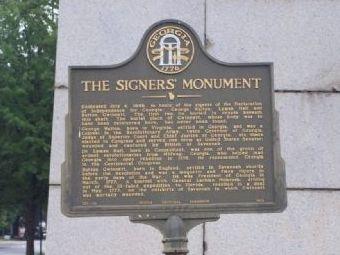
Section Branding
Header Content
Georgia's Role In Independence Day
Primary Content

America finalized the Declaration of Independence on July 4, 1776. 56 members of the Continental Congress signed it, signifying the American Colonies’ release from the hold of Great Britain.
According to www.ushistory.org, three men from the fledgling state of Georgia signed the document.
Lyman Hall studied medicine at Yale, and was in charge of providing medicine and provisions to the Armies fighting in the Revolutionary War. Georgian leaders had originally not been interested in sending a representative to the Continental Congress, but Hall persuaded them that Georgia needed to be heard.
When the War reached Georgia in 1777, British troops burned Hall’s land, and accused him of high treason. He fled, but family in Connecticut protected him and he eventually returned to Georgia. He was elected as Governor in 1783 and advocated the creation of a state university. The University of Georgia opened just a few years later. He remained in politics for the rest of his life, until his death in 1790 at the age of 66.
Hall County was named in honor of Hall and numerous elementary schools bear his name.
One of Hall’s colleagues was George Walton. Though not much is known about Walton’s early life, he was deeply involved in the development of Georgia. He studied law in Savannah, and passed the Bar Exam in 1774. Walton was elected secretary of the Georgia Provincial Congress. He went on to serve in the Continental Congress in 1776.
In 1778, Walton joined the American Revolutionary War as a Colonel for Georgia, and was taken prisoner. When he was released, he was elected as the Governor of Georgia, but he only held the office for two months, due to political turmoil in the state.
Over the course of the rest of his life, Walton served as Chief Justice of Tennessee, a member of the Electoral College of Georgia, a trustee for the University of Georgia, and served another term as Governor. He was elected as a superior court judge, and filled an empty state Senate seat. When he was not reelected to the Senate, he retired to a farm. He died in Augusta at the age of 64 in 1804.
Walton County bears his name, along with several schools.
The third Georgian man who played a significant role in the creation of the United States was Button Gwinnett. Gwinnett was the only man of the three who was born in England. He moved to America, and bought land in Georgia in 1765. In 1776, he was made commander of Georgia’s continental militia, and was elected to the Continental Congress. He returned home to Georgia shortly after signing the Declaration.
Gwinnett then became embroiled in political battles with his rival, a soldier named Lachlan McIntosh. McIntosh would go on to attain very high military and political positions. Gwinnett was chosen to succeed the leader of the Council of Safety, but used his position to invade Florida, in order to secure Georgia’s border. His plans were thwarted by McIntosh, and Gwinnett gave up.
He attempted to run for Governor of Georgia, but was defeated. Soon after, McIntosh challenged his honor, which led to a public duel. Both men were wounded, but McIntosh eventually recovered. Gwinnett died 3 days later, at the young age of 42.
Gwinnett County was named in his honor.
A Signer’s Monument is located in Augusta, Georgia. It is a granite obelisk that sits where the City Hall was located in 1848.
Organizers decided to bury the remains of Hall, Walton, and Gwinnett the base of the memorial. Lyman Hall and George Walton’s remains were found and moved to Augusta, but the burial site of Button Gwinnett was never definitively located. It is believed that he was buried along a street in Savannah, but there was no grave marker.
The Signers Monument was dedicated in 1848.
Tags: Gwinnett, Hall, Walton, United States history, US history, Declaration of Independence, signers
